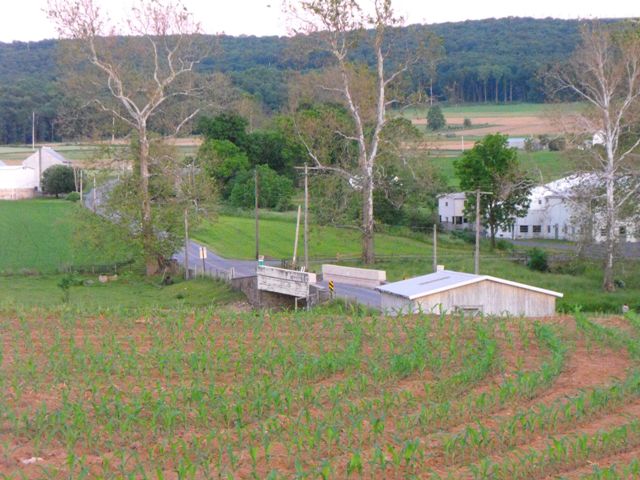We Recommend:
Bach Steel - Experts at historic truss bridge restoration.
BridgeHunter.com Phase 1 is released to the public! - Visit Now
Bootjack Road Bridge

Primary Photographer(s): Nathan Holth and Rick McOmber
Bridge Documented: May 30, 2010
Rural: Lancaster County, Pennsylvania: United States
1914 By Builder/Contractor: John T. Brubaker and Engineer/Design: Frank H. Shaw of Lancaster, Pennstlvania
Not Available or Not Applicable
48.0 Feet (14.6 Meters)
50.0 Feet (15.2 Meters)
20 Feet (6.1 Meters)
1 Main Span(s)
36720309180301

View Information About HSR Ratings
Bridge Documentation
This bridge's future is at risk!
Bridge Status: This bridge is slated for demolition by Lancaster County!View Archived National Bridge Inventory Report - Has Additional Details and Evaluation
View Updated 2021 Historic Bridge Inventory Sheet For This Bridge
Lancaster County's engineers built a large number of concrete through girders, something most other places in Pennsylvania did not do. A noteworthy number of them remain in the county today, however many are threatened with demolition. Concrete through girders, despite their rarity, are often ignored by state historic bridge inventories and their significance often goes unrecognized. Although perhaps among the more simple and unadorned of historic bridge types, these utilitarian structures still convey a sense of age, and the simple inset rectangle shapes and marble plaques on the Lancaster County girders show that even with simple bridges like this, engineers of the early 20th Century refused to design a bridge as ugly as the slabs of concrete that pass for bridges in the 21st Century. Because concrete through girders are rare on a state level, all surviving girders in Lancaster County that retain good historic integrity should be considered significant. Concrete through girder bridges represent the period of experimentation that accompanied the use of concrete in bridge construction during the first couple decades of the 20th Century. Concrete girder bridges were in many ways a failed experiment because they could not normally be economically built with deck widths much wider than 20-22 feet, and so as the need for wider bridges became apparent moving into the 20th Century, concrete through girders quickly fell from favor, and were generally not built after 1930. Because they are rare today and represent a period of experimentation in bridge design, HistoricBridges.org considers concrete through girders to be significant.
This bridge is a good representative example of a Lancaster County through girder. Constructed in 1914, the bridge is among the earlier examples of the concrete through girder. Handsome stone abutments offer an interesting contrast to the concrete girder superstructure. The bridge retains marble plaques and seems to be in decent condition. Amish population living in the region reduces the amount of heavy, motorized traffic on these bridges. A bulky concrete girder bridge like this can easily carry horse and buggy traffic, and its narrow width acts as a traffic calming measure, helping ensure that motorized traffic maintains a reduced speed in a region with significant horse and buggy traffic. Regardless, this bridge was included on a Lancaster County bridge removal list. Demolishing this bridge seems to be a waste of money. Minor repairs and maintenance would keep this bridge open for horse and buggy traffic as well as light motorized vehicles.
Information and Findings From Pennsylvania's Historic Bridge InventoryDiscussion of Bridge The single span, 50'-long, reinforced concrete thru girder bridge built in 1914 is supported on stone abutments with concrete bridge seats. The girders are paneled below the thicker top flange section. A transverse concrete slab spans between the girders. The bridge is an example of one of the least successful standardized reinforce concrete bridges types developed during the first decade of the 20th century. At least 65 thru girder bridges from 1906 to 1930 have been identified with more than one-third of the examples in Lancaster County where their use was forwarded by county engineer F. H. Shaw beginning before 1910. The bridge is not historically or technologically distinguished by its setting or context. Discussion of Surrounding Area The bridge carries a 2 lane road over a stream in a rural area of active farms and scattered 20th century houses and businesses. A modern light industrial building is located at the southwest quadrant. The township garage is at the northeast quadrant. A farm complex with 19th century stone barn is located at the northwest quadrant. The setting does not have the cohesiveness or integrity of a historic district. [Note: The Phase 2 survey form noted this bridge might be adjacent the NR-listed Windsor Forge Mansion. That was incorrect. The mansion is located more than 1/2 mile to the west. The bridge is not related.] Bridge Considered Historic By Survey: No |
![]()
Photo Galleries and Videos: Bootjack Road Bridge
Bridge Photo-Documentation
Original / Full Size PhotosA collection of overview and detail photos. This gallery offers photos in the highest available resolution and file size in a touch-friendly popup viewer.
Alternatively, Browse Without Using Viewer
![]()
Bridge Photo-Documentation
Mobile Optimized PhotosA collection of overview and detail photos. This gallery features data-friendly, fast-loading photos in a touch-friendly popup viewer.
Alternatively, Browse Without Using Viewer
![]()
Crossing The Bridge
Full Motion VideoStreaming video of the bridge. Also includes a higher quality downloadable video for greater clarity or offline viewing.
![]()
Maps and Links: Bootjack Road Bridge
Coordinates (Latitude, Longitude):
Search For Additional Bridge Listings:
Bridgehunter.com: View listed bridges within 0.5 miles (0.8 kilometers) of this bridge.
Bridgehunter.com: View listed bridges within 10 miles (16 kilometers) of this bridge.
Additional Maps:
Google Streetview (If Available)
GeoHack (Additional Links and Coordinates)
Apple Maps (Via DuckDuckGo Search)
Apple Maps (Apple devices only)
Android: Open Location In Your Map or GPS App
Flickr Gallery (Find Nearby Photos)
Wikimedia Commons (Find Nearby Photos)
Directions Via Sygic For Android
Directions Via Sygic For iOS and Android Dolphin Browser
USGS National Map (United States Only)
Historical USGS Topo Maps (United States Only)
Historic Aerials (United States Only)
CalTopo Maps (United States Only)


